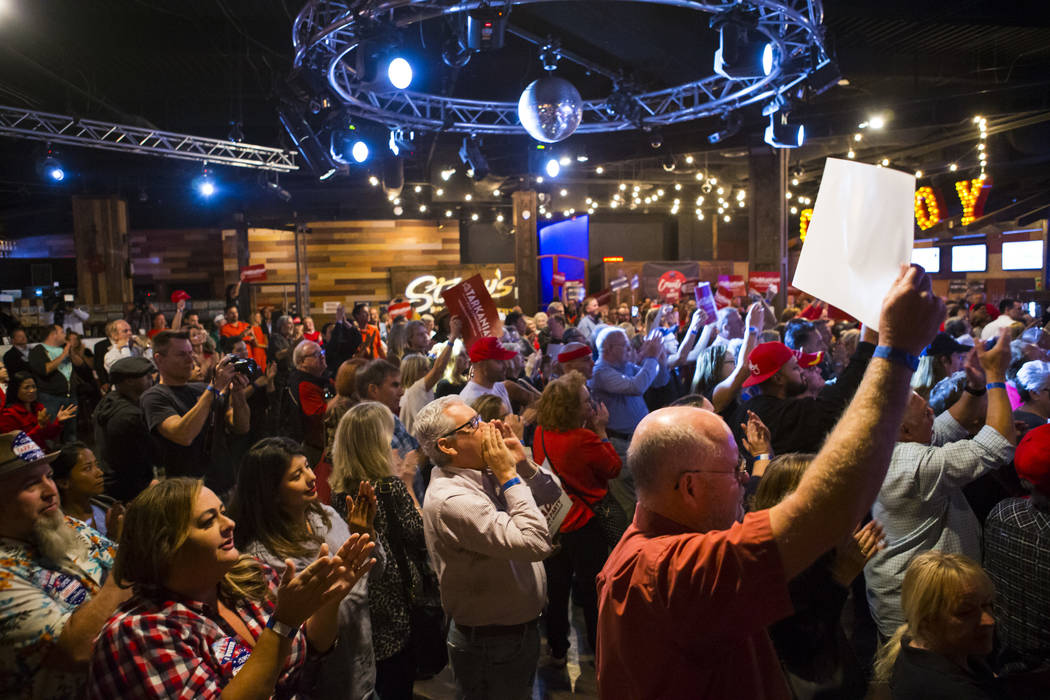Nevada in spotlight as midterm vote could be referendum on Trump

WASHINGTON — A surge in early voting enthusiasm has Democrats hopeful they will take control of the House for the first time in eight years, while President Donald Trump’s hard-line blitz on immigration has Republicans confident they will keep their Senate majority.
Leaders in both parties were making their closing arguments and trying to get their voters to the polls in House and Senate races that are expected to be close across the nation, including Nevada with high-profile contests for Senate, governor and two House seats.
The battle will be over Tuesday, when Americans head to the polls to cast ballots in midterm elections largely seen as a referendum on Trump’s first two years in office.
Historically, the party that controls the White House loses seats in midterm elections — particularly when the president’s approval rating is below 50 percent.
Various public opinion polls have shown Trump’s approval rating hovering around 42 percent, and likely voters nationwide favor Democrats slightly over Republicans on generic ballots.
But as the late House Speaker Tip O’Neill Jr., D-Mass., put it: “All politics is local.”
Contests will be decided, ultimately, on local candidates with the president’s popularity serving as a backdrop.
And despite a high turnout of early voters, Election Day turnout remains crucial, particularly for Democrats reliant on voting blocs of minorities and younger, first-time voters, who historically vote in smaller percentages than elderly white Republicans.
Key Nevada races
In Nevada, Democrats are playing defense on two open House seats while Republicans are fighting to save Sen. Dean Heller, the only GOP senator running for re-election in a state that Hillary Clinton won in 2016.
Heller is in a tight race with Democratic Rep. Jacky Rosen, with most polls showing the contest within the margin of error in the final week.
Democrat Susie Lee is in a competitive race with Las Vegas attorney Danny Tarkanian for the House seat Rosen is vacating.
And two former congressmen, Democrat Steven Horsford and Republican Cresent Hardy, are in a battle to win the seat currently held by Rep. Ruben Kihuen, D-Nev., who is not running for re-election.
Nationally, there are 35 Senate races, 435 House races and 36 gubernatorial contests. To win back the House, Democrats need to pick up 23 seats.
House elections expert David Wasserman with the non-partisan Cook Political Report this week projecting that Democrats could pick up as many as 30-40 seats.
Other political prognosticators also see Democratic House gains.
Even House Minority Leader Nancy Pelosi, D-Calif., predicted, “We will win!” on “The Late Show with Stephen Colbert.”
The early prediction evokes painful memories for some Democrats who remember 2016 when polls and pundits were confident of Hillary Clinton’s presidential victory — only to be surprised at Trump’s triumph at the polls.
Trump’s prediction
Trump also issued an early prediction, saying the “blue wave” of Democratic enthusiasm “is dead.”
Republicans got a bounce with the confirmation of Judge Brett Kavanaugh to the Supreme Court. But those gains have diminished, and Trump has since pivoted to red meat cultural issues to fire up and stoke his base of Republican and conservative voters.
Out of nowhere, the president proposed a 10 percent middle class tax cut, in addition to the GOP tax cut package passed in 2017. The offer surprised congressional leaders, who are in recess until after the election.
Trump then announced his intent to send active-duty troops to the U.S.-Mexico border to block a caravan of refugee families he has tagged as an “invasion,” and he suggested he could bypass the Constitution and eliminate birthright citizenship with an executive order.
The final-hour gambit was seen by strategists in both major political parties as trying to hold the GOP majority in the Senate by using cultural issues to turn out voters in states with Democratic senators like Jon Tester in Montana, Claire McCaskill in Missouri and Joe Donnelly in Indiana.
Trump also is holding 11 rallies in the final six days to move conservatives to the polls.
In Nevada, former President Barack Obama and former Vice President Joe Biden have campaigned for Rosen in vote-rich Las Vegas. Trump and Vice President Mike Pence campaigned in Ely and Las Vegas for Heller, but not since the immigration blitz was launched.
“He’s concentrating exclusively on the Senate,” GOP strategist Matt Mackowiak said of Trump’s final strategy, campaigning in states the president won in 2016 where Senate Democrats are on the ropes.
Suburban challenge
Republicans have faced challenges from the beginning in suburban districts, where the president’s poll numbers with educated voters and women are low. The president’s value is in rural, midwestern areas, Mackowiak said.
“The president is not popular in swing districts,” Mackowiak said. “The question is where can he make the most difference in the closing days.”
The suburbs are also home to many registered independents, whose clout at the ballot box this year carries more weight because of the extreme polarization of the nation along party lines.
While most polls show independents favoring Democratic candidates over Republicans on a generic ballot, they also show that those voters are more turned off by Pelosi than by Trump.
How independent voters break in states and cities could likely be the deciding factor in which party controls the House.
To that end, the president’s attacks on immigrants and refugees could help drive educated suburban voters to Democratic candidates on Tuesday’s ballot.
Despite predictions of a wave turnout, the actual tally on the House and possibly the Senate could take days to determine because many races are close and that could trigger automatic recounts in some states.
Contact Gary Martin at gmartin@reviewjournal.com or 202-662-7390. Follow @garymartindc on Twitter.